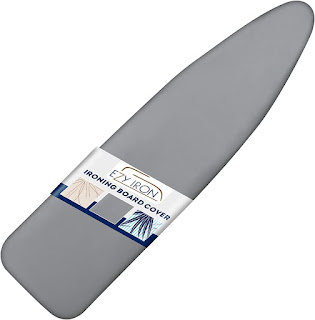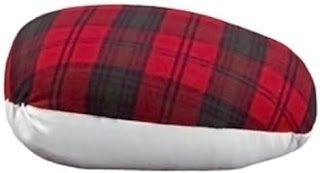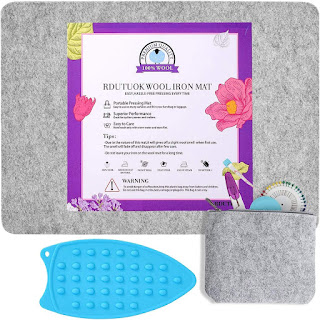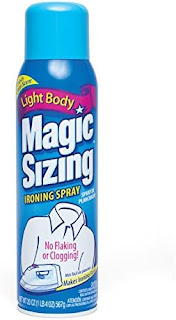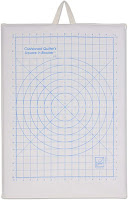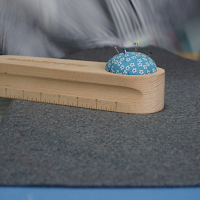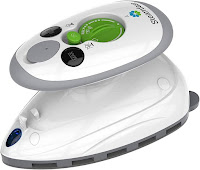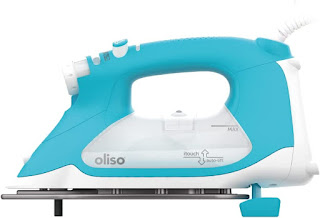Monday, October 23, 2023
Saturday, August 12, 2023
Products That Make Sewing Easier As I Get Older
I'm not ancient but I am getting older. Fifteen years of living with rheumatoid arthritis has taught me to look for ways to make my life easier so I can continue to sew the beautiful heirloom garments I love so much. Today I want to share with you some of the products I use to help me aid me in making these garments.
Hoop Stand
It is made from hard beechwood and sanded to a fine finish. It can be used as a table stand but I position it between my legs and sit on the base. The adjustable knobs help to get the embroidery hood in the best position for working on the embroidery. Handsfree eases the pressure on my joints plus I think my stitches much neater.
Electric Scissors
If I am cutting more than one layer of fabric, I use my electric scissors. They will cut multiple layers at a time speeding up the cutting out process. Batch cutting my pattern pieces is a real time saver. The electric scissors come with two rechargable batteries so there is always one charged to use when the other is getting slow. The scissors are not heavy so they are easy to hold. Plus, they are cordless so there is no cord to get in the way or get cut through. Mine were purchased on Amazon. Click on the link below to find the ones I use. The ones I use are out of stock at Amazon but here is a link to a similiar set.
Honestly, my GrabbIt magnetic pincushion has been a staple in my sewing studio or over twenty years. It holds my pins securely and makes cleanup a breeze. I don't use the pins that came with it.
The Oliso Iron ProPlus Smart Iron
I first saw this iron on a You Tube video. It think it was a video by Sarah Ward with Sarah Classic Sewing. The Oliso has a clever auto-lift function. With a gentle touch on the handle, the iron effortlessly descends, poised for action. Release your grip, and the innovative scorch guards, a patented feature, gracefully raise the iron, safeguarding your fabrics from scorching. Leaving the iron in a horizontal position not only enhances safety but also optimizes efficiency, while providing relief to your wrists and shoulders. It also available in some fun colors!
Compact Iron
The Steamfast Mini Iron is the compact iron I use everday. It stays on my sewing table while I sew. The grip on the iron is very comfortable for my hand. It's light weight is easy on my hands and arm. The steam function is great and it even has a burst of stem feature. Click on the link and you can see the features of the iron and purchase.
There is another mini project iron I would like to try. It is by Oliso -same brand as my full size iron. I will link it below and provide a picture.
There are other products I will purchase in the future as I see the need so I can continue doing what I am so passionate about - Heirloom Sewing and Hand Embroidery.
Have a fabulous day,
A small commission is earned off the sale of a product linked in this article.

Monday, July 3, 2023
Sewing Essentials Part 3 - Ironing Essentials
Anyone who sews knows pressing and ironing are an essential part of sewing. Seams have to be pressed to seal in the stitches and then pressed open or to one side. Hems are ironed in and sleeves are steamed. Below are items I use in my sewing studio every day and where you can purchase them.
I. An extra large ironing board the one I use is wider than the normal size ironing board and has a place to rest your iron on one end. It is called the Honey-Can-Do Adjustable Deluxe Ironing Board with Iron Rest
2. I wasn't crazy about the striped cover that came with the ironing board so I purchased one with extra padding. Padded Cover
3. My ironing ham is used for so many things like ironing open seams. The curved seams conform to the shape of the ham. There is a cotton side and a wool fabric side.They are acually called a Dress Makers Ham and you can purchase one by Dritz online at Farmhouse. https://farmhousefabrics.com/pressing-tailor-s-ham-by-dritz-8-28-20
There are also lots of You Tube tutorials on how to make your own.
4. The rajah pressing cloth is used to to press in creases or take out creases. The heat of the iron releases a chemical that is like magic. The chemicals won't harm your fabric. I purchased mine and Farmhouse fabrics and here is the link: https://farmhousefabrics.com/rajah-pressing-cloth
5. Parchment paper is very useful when ironing. It protects your iron and your fabric.
6. I discovered the wool pressing mat while watching a Farmhouse Fabrics Gab & Gush. The heat gets into the wool and both sides of your fabric is pressed. Below are two links where you can purchase a wool pressing mat. Amazon - https://amzn.to/3NtBRQ0 or Farmhouse Fabrics- https://farmhousefabrics.com/wool-pressing-mat-thick
7. Now let's talk about starchs. There are several opinions on when and if to use starch on fabrics. I use three types of starch depending on what I am working on. First is Mary Ellen's Best Pressed Starch. This is my favorite starch to use with heirloom sewing. It is light weight and gives a beautiful finish to the garment.
If I use Magic Sizing for "touch-ups". It is a light weight finish and gives so much body to your garment. https://amzn.to/4498xpg
Faultless Starch has been around for years and is a trusted brand. There are several types but I like the gold can the best. You can find it at grocery stores and big box stores but I usually order several cans at a time and purchase it through Amazon. https://amzn.to/3JGuyUa
Thank you for staying until the end of this post. I hope my suggestions help you in your sewing journey. I am an Amazon affiliate so if you order from one the Amazon links in this post, I receive a small commission. Have a great day!

Saturday, May 27, 2023
Sewing Essentials Part 2
It is great for ironing open seams. It is 110V. Power: 150W. Heating plate size: 1.9"x3.3". Auto power-off after 15 minutes no use. I love the auto power-off feature and the pretty raspberry color. Mine is blue!
Cricut Mini Heat PressMy June Tailor Cushioned Mat make a great small ironing surfacesurface beside my sewing machine. I can quickly press open a seam or block my smocking pleats. The one I use has a smocking block guide on one side and a diamond and scallops shape guide on the other side. It is no longer available but this one Amazon will also work.

Saturday, May 20, 2023
Different Types of Elastic and How They are Used
If you are like me, it is confusing to know which elastic to use for sewing projects. Hopefully, the following will clear up some of the confusion. It starts with an explanation of elastic and then gives examples of four types of elastic and where they would be used.
Elastic is a flexible material frequently used in a variety of products. Elastic comes in a number of diff erent varieties, each having special qualities and uses. Fibers are interlaced to form a sturdy and long-lasting fabric to produce woven elastic. It has exceptional elasticity and a snug fit, and is frequently used in clothing, belts, and upholstery. By weaving together numerous rubber or latex strands, braided elastic is created, which is robust, light, and extremely stretchable. It is frequently used in sleeves, waistbands, and other areas where comfort and flexibility are crucial. Swimsuit elastic is made especially to survive exposure to chlorine and water, keeping its elasticity and shape even when wet. It frequently appears in swimsuits. Below are examples of elastic types and their uses.
Woven Elastic:
- Roll and twist resistant elastic; great for waistbands
- It is suitable for waistbands, sleeves, necklines, legbands and more.
Braided Elastic:
- Braided elastic is shrink resistant and unaffected by chlorine and salt water.
- Braided elastic is often inserted in to a casing but it is also suitable for stitching directly to the fabric.
- Use with light to medium weight fabrics
- Machine washable and dryable in temperatures up to 200 degrees F
- When it comes to selecting the ideal fabric for your kids' clothing, factors such as comfort, breathability, and safety are of utmost importance.
- made with polyester silk and natural latex rubber making it breathable with a comfortable feel.
- offers excellent stretch with long-lasting elasticity guaranteed not to loosen over time.
- us for pajama pants to sportswear, skirts, and necklines.
Swimsuit Elastic:
Swimsuit elastic refers to a type of elastic material specifically designed for use in swimwear construction.It is a flexible, stretchable component used to provide support, comfort, and a secure fit in swimsuits.
Swimsuit elastic is typically made from a combination of synthetic fi bers, such as spandex or elastane, which possess excellent elasticity and resistance to degradation caused by exposure to chlorine, saltwater, and sunlight.
- The elastic is often sewn into the edges of swimsuit fabric or incorporated into waistbands and leg openings to ensure the swimsuit conforms to the body and maintains its shape during movement and water activities.
- Available in clear, colors, and cotton.
Sally from Farmhouse Fabrics give a great presentation on the types of elastic in this You Tube Video:
If you have never watched Sally on Gab 'n Gush on Tuesdays and Fridays, please watch. I think you will enjoy it. Sally is the owner of Farmhouse Fabrics. Farmhouse Fabrics is an ecommerce fabric and notions store with thousands of selections. Here is the link:
For people with with latex allergies, there also elastics available. Other elastic types to explore are elastic thread, elastic thread looks, elastic in colors, decorative elastic. There are seemingly endless types of elastic. With some research, you can find the perfect type for your project.
Happy Saturday!

Saturday, April 29, 2023
Sewing Essentials Part One
As you can see from the picture, it is by Oliso and it is a smart iron. It's unique feature lies in the soleplate, which is capable of ascending and descending with a simple touch of the handle. Click here to go to Amazon and purchase. https://amzn.to/3ABpLyu
Nest, is my favorite and most used scissors. In my humble opinion, Gingher brand scissors are the best on the market for sewing. I really like this pair with the lock on them. They are so comfortable to use and cut with precision!Next up on my list of must-have sewing essentials if a seam ripper. I've owned different brands but my favorite is by Bernina.
Several places sell them online and I don't remember where I purchased mine but here is a link to a place online that sells them. I buy multiples!
My cutting table is where all projects start. I purchased it and the mat many years ago from JoAnn fabric store.

Saturday, November 5, 2022
How It All Began
I fell in love with French Hand Sewing and English Smocking when my first daughter was an infant. I've sewn and done simple hand embroidery since I was about nine years old. My first project on a sewing machine was an apron for 4-H when I was nine years old. Both my mother and my grandmother had sewing machines. I still remember the clothing my mother made me growing up. My husband, children, and I spent summer vacations at his parents house. The first summer after my daughter was born, a friend of my mother-in-laws taught me how to pleat, smock, and construct a bishop dress. My mother-in-law (Tommie) purchased a pleating machine and I've never stopped smocking.
After returning home that summer, I looked in the yellow pages (yes, there used to be a book published listing all the local businesses) and found that Tuscaloosa, Alabama had a smocking and heirloom sewing shop called Sew Fancy. Later the name was changed to Sew So Fancy. I still remember getting my 19 month old and 6 month old out of the van, putting them in their double stroller and wondering how I was going to get them up the stairs of the old Victorian house where the shop was located. Luckily, the owners of the shop saw me and helped get the stroller into the store. A life long friendship began that day between me and those two sweet women, Swiss Batiste, and French lace.
The world of heirloom sewing was new to me and I desparately wanted to learn all about it. One of the first things I learned was there were two techniques; french sewing by hand and french sewing by machine. French sewing my hand has been used for many generations and uses the finest fabrics and laces so in order for me to try to duplicate the look on the machine, I knew I needed to first learn the technique by hand.
Lessons were a must as were books by Sarah Howard Stone.
During my class, I learned all the techniques from a great teacher and friend. This was a hands on project so I had to select what I wanted to make. My daughter had auburn red hair so I decided aqua Swiss Batiste and ecru laces would be a good choice. Below are pictues of the finished results.













